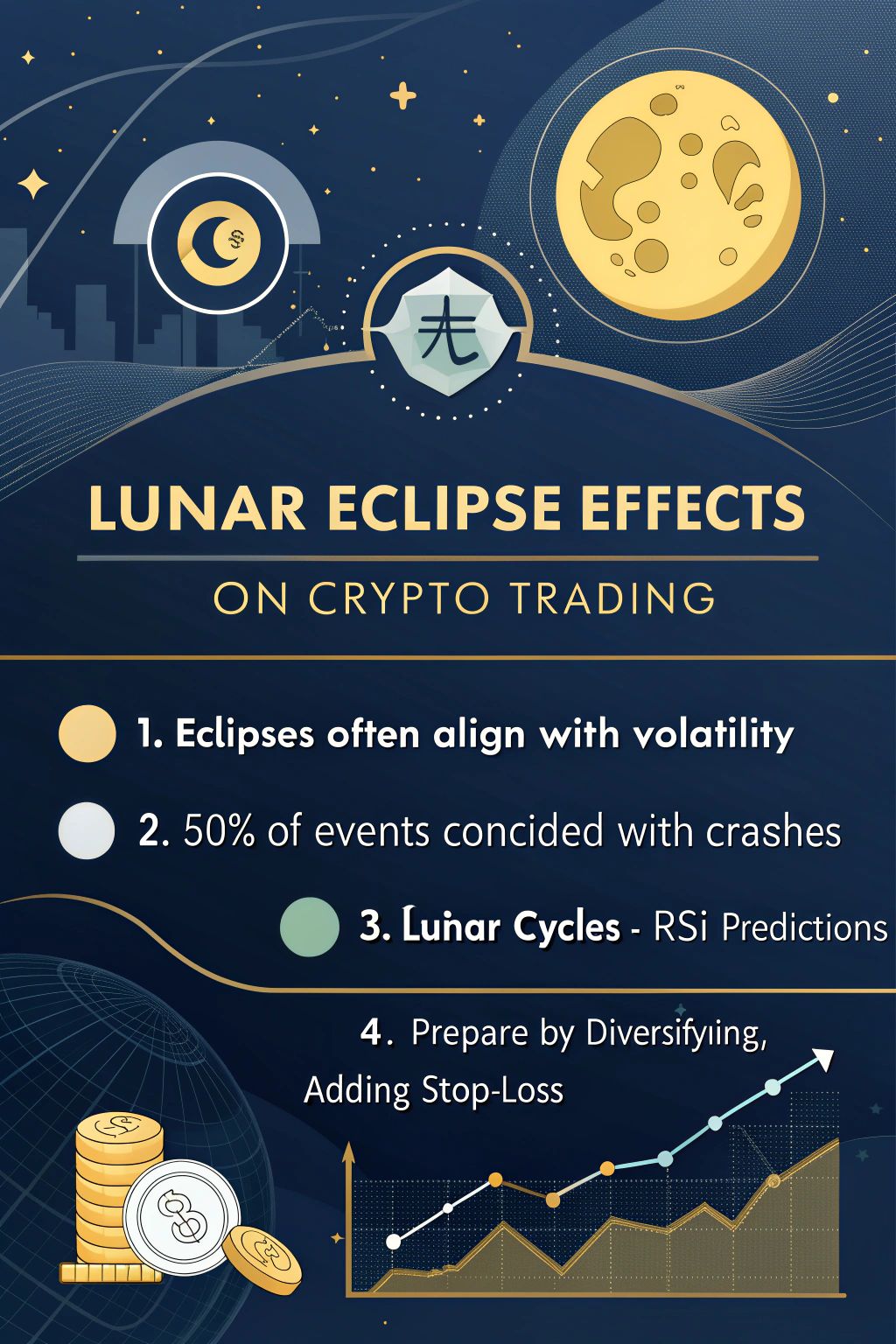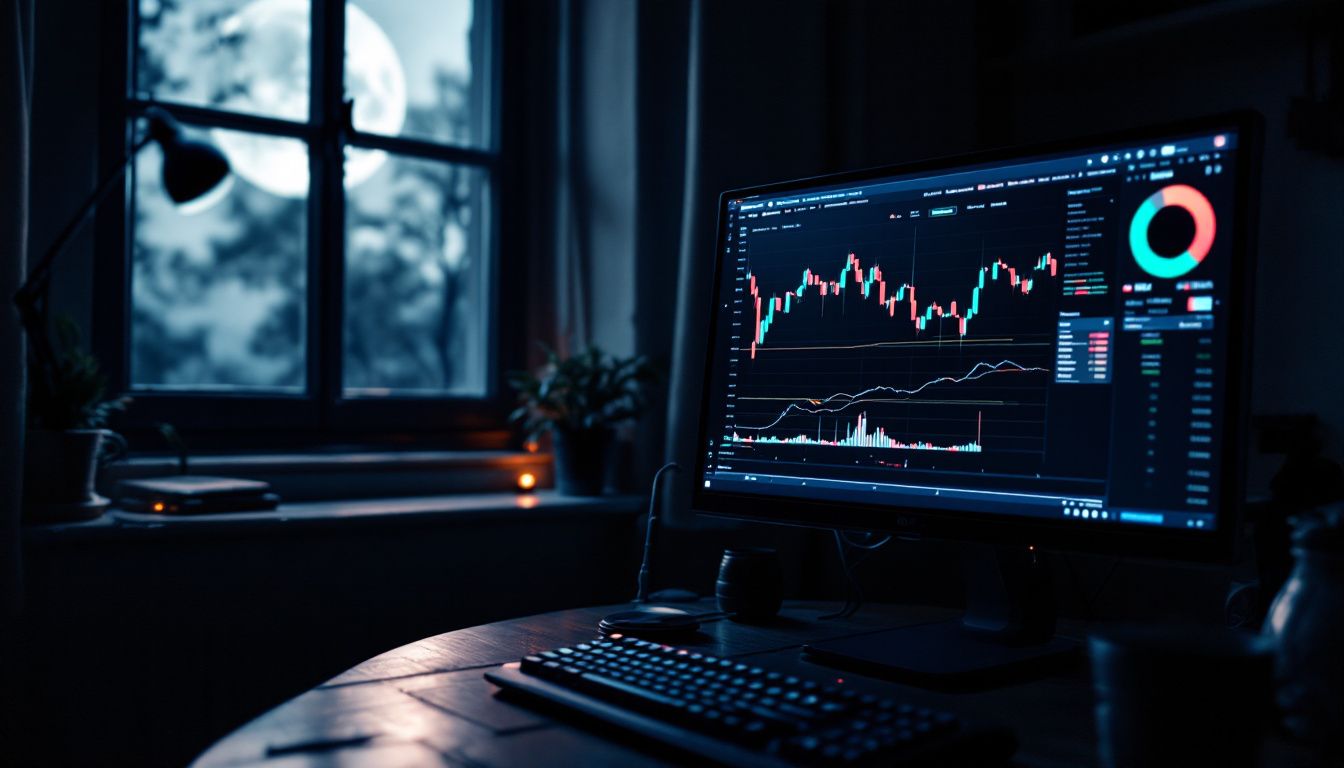Crypto trading is already tough, but market swings during lunar eclipses raise eyebrows. Some say the moon’s shadow stirs up more than just the sky—it rattles investor sentiment too.
This blog breaks down whether these celestial events truly impact tokens or if it’s all superstition. Keep reading to uncover surprising insights!
Principales conclusiones
- Lunar eclipses often align with crypto market volatility. Examples include Bitcoin’s 20% drop on November 8, 2022, during a total lunar eclipse and the May 2022 LUNA crash.
- Out of six major lunar eclipses from 2014–2022, three coincided with significant crypto crashes. However, correlation does not prove causation.
- Traders blend astrology with tools like RSI and Bollinger Bands to predict trends. For instance, Didi Taihuttu’s “Didi BAM BAM” indicator uses lunar cycles alongside technical analysis.
- Skeptics argue astrological trading relies on confirmation bias rather than real market fundamentals like regulations or risk management issues (e.g., UST’s collapse).
- Preparing for potential swings during future eclipses can help traders mitigate risks by setting stop-loss orders or diversifying portfolios ahead of events like March 14, 2025’s total eclipse.

Understanding the Lunar Eclipse

A lunar eclipse happens when Earth blocks sunlight from reaching the moon. This rare event stirs curiosity in both science and financial markets alike.
Definition and Occurrence
A lunar eclipse happens when Earth’s shadow blocks sunlight from hitting the moon. This occurs during a full moon, as Earth sits between the sun and the moon. There are three types: total, partial, and penumbral.
A total lunar eclipse makes the moon appear red, often called a “blood moon.”.
These events are rare but predictable. Total lunar eclipses happen about twice per year. For example, on November 8, 2022, a total lunar eclipse coincided with significant turbulence in crypto markets like Bitcoin and Ethereum.
Historical Significance in Finance and Astrology
The Moon has long influenced human behavior and decision-making. Ancient traders believed celestial events, like lunar eclipses, could affect markets. In the 1600s, astrologers advised merchants on when to buy or sell goods based on planetary movements.
Financial decisions tied to astrology were not uncommon in early stock markets too. Patterns between eclipses and investor sentiment have intrigued people for centuries.
Today, some still blend astronomy with finance. TikTok astrologist Maren Altman uses star charts to predict Bitcoin trends, gaining a large following online. Didi Taihuttu even developed an algorithm combining lunar cycles with technical trading tools for crypto investments.
These examples show how history repeats itself as traders explore the Moon’s potential link with price volatility in financial assets like cryptocurrencies and stocks.
The Moon-Crypto Connection: Myth or Reality?
Some traders swear the moon influences market sentiment. Others argue it’s nothing but superstition tied to old beliefs.
Overview of Astrological Beliefs in Markets
Astrology has long influenced financial markets. Many traders tie celestial events like the full moon, solar eclipses, and total lunar eclipses to market sentiment. The belief is simple—cosmic shifts impact human emotions, which then drive trading behavior.
Didi Taihuttu, a crypto investor, blends astrology with tools like Bollinger Bands and RSI for market predictions. His “Didi BAM BAM” indicator reportedly gained 50% since the bear market bottom.
Such systems show how astrological theories mix with technical analysis in today’s volatile cryptocurrency market.
Markets are driven by fear, greed—and sometimes—moon phases.
Studying Correlations Between Lunar Cycles and Crypto Volatility
Studying whether lunar cycles affect crypto volatility isn’t just for horoscope enthusiasts. Let’s break it down step by step, minus the fluff.
| Aspecto | Key Points |
|---|---|
| Crypto Volatility vs Lunar Events | – Several events align with market drops during eclipses. – Historical data shows a connection in some years, but not all. – Example: November 8, 2022, saw a significant Bitcoin crash. |
| Statistical Evidence | – Out of 6 notable lunar eclipses between 2014–2022, 3 coincided with market crashes. – April 15, 2014, marked a crash. – May 26, 2021, repeated the pattern. – Correlation doesn’t confirm causation. |
| Potential Explanations | – Traders often rely on psychological factors during uncertain times. – Lunar cycles tie into broader fears or speculation. – Certain investors chase trends during celestial events. |
| Why Some Ignore It | – Critics argue markets move due to fundamentals, not the Moon. – Skeptics label it as confirmation bias. – Solid data separating fact from coincidence is rare. |
| Notable Example: The LUNA Fall | – May 2022’s lunar eclipse coincided with the LUNA and UST collapse. – Billions erased from crypto markets. – Seen as one of the largest crashes tied to an eclipse. |
Historical Data on Lunar Eclipses and Crypto Market Reactions
Lunar eclipses have coincided with major shifts in the cryptocurrency market. Some investors link these events to increased volatility and changing market sentiment, sparking debates about celestial influences on trading behaviors.
The Nov 8, 2022, Crypto Crash: A Deep Dive
A total lunar eclipse on November 8, 2022, coincided with turmoil in the crypto market. FTX’s downfall caused an 80% plunge in its FTT token. Investors reacted with alarm as confidence disintegrated rapidly.
Bitcoin was affected as well. Its value fell by 20%, reaching $15,680—the lowest point in two years. This downturn revealed vulnerabilities in decentralized finance and unsettled investor confidence globally.
The May 2022 Crash: Analyzing the Fall of LUNA and UST
On May 16, 2022, the cryptocurrency market faced a major shock. Bitcoin fell below $26,000 and Ether dropped under $2,000. Over $200 billion vanished from the market in just one day.
The collapse of TerraUSD (UST), an algorithmic stablecoin tied to the U.S dollar, triggered this chaos. UST’s value plummeted from $1 to just $0.12.
LUNA, Terra’s sister token designed to stabilize UST, faced a sharper downfall. Its price nosedived over 99.99% year-to-date—from $116 to nearly nothing at $0.0002 per coin. This crash wiped out around $18 billion in value for Terraform Labs’ ecosystem and shook investor confidence across financial markets worldwide.
Analyzing the Impact of Lunar Eclipses on Bitcoin
Bitcoin often reacts strangely during celestial events like lunar eclipses. Some traders spot patterns in price swings, while others blame pure chance.
Price Fluctuations During Recent Eclipses
Price shifts during lunar eclipses stir curiosity. The connection between these celestial events and crypto markets is debated. Here’s a glance at how Bitcoin and crypto assets moved during recent eclipses:
| Date | Event | Crypto Market Impact |
|---|---|---|
| May 26, 2021 | Total Lunar Eclipse | Market declined sharply. Bitcoin dipped below $40,000. Altcoins followed suit. |
| November 8, 2022 | Total Lunar Eclipse | Bitcoin plunged 20%. FTX collapse drove BTC to $15,680, its lowest in two years. |
| January 31, 2018 | Super Blue Blood Moon | Crypto market tumbled. Bitcoin lost over 10% on the same day. |
Market timing appears aligned with major celestial events. Coincidence or something more? Traders often wonder if lunar movements nudge the needle.
Predictive Analysis: Astrology vs. Market Fundamentals
Astrology ties crypto trends to celestial events like lunar eclipses. Some traders use moon phases and zodiac signs for timing trades. Platforms like TikTok amplify these ideas, with astrologists such as Maren Altman shaping investor sentiment.
These beliefs impact short-term decisions and create volatility in financial markets.
Market fundamentals tell a different story. Crypto prices often shift due to regulations, trading volume, or interest rates—factors unrelated to lunar cycles or retrograde motion.
For example, the collapse of LUNA and UST in May 2022 was driven by weak risk management, not a super flower blood moon event. Skeptics argue that astrology can cause confirmation bias rather than drive real asset bubbles or shocks in cryptocurrency markets.
Future Projections: Upcoming Eclipses and Expected Market Movements
Upcoming lunar eclipses could stir up crypto markets. Traders may need to brace for surprises as celestial events often coincide with volatility spikes.
Dates of Future Eclipses
Lunar eclipses fascinate many, but can they affect crypto markets? Marking key dates is crucial for traders.
- March 14, 2025
A total lunar eclipse will occur on this day. It could spark higher market volatility. Traders might see sharp cryptocurrency price swings as investor sentiment shifts.
- September 7, 2025
This partial lunar eclipse follows six months after the total one. Financial markets may experience movement as emotions and astrological beliefs mix. Watch Bitcoin and smaller cryptocurrencies for sudden changes.
- March 3, 2026
Another penumbral lunar eclipse happens here. While it’s the least visible type, some astrologers still tie it to market activity. Investors should keep a close eye on technical indicators like the Relative Strength Index (RSI) or stochastic oscillator during this period.
Tracking these celestial events gives crypto enthusiasts time to prepare strategies. Trading high-risk assets during such dates may require proper risk management tools or portfolio diversification plans to limit losses caused by unexpected swings.
Astrological Predictions and Expected Market Trends
Eclipses often stir debate in financial astrology. Some astrologers predict heightened market volatility around future celestial events like the total lunar eclipse on March 25, 2024.
They associate the moon’s energy shifts with changes in investor sentiment and risk tolerance.
Crypto markets may react to these psychological triggers, leading to sharp deviations in price trends. For example, Taihuttu observed potential links between moon phases and Bitcoin options activity.
While no solid proof exists linking eclipses to crypto movements, traders who study behavioral finance still pay attention during such periods. Celestial events like a super flower blood moon could bring unpredictable swings in cryptocurrencies or high-yield bonds.
Actionable Trading Tips During Lunar Eclipses
Be ready for sudden price swings during lunar eclipses. Use smart strategies to protect your investments and spot new chances in the market.
Preparing for Volatility: Strategies for Traders
Set stop-loss and take-profit limits to guard your trades. These tools help lock in profits or cut losses during wild price swings. Stick to the “1% rule.” Risk no more than 1% of your total account on a single trade.
This reduces heavy losses during unexpected drops.
Stay updated on lunar eclipse dates, as they may spark market movement. For example, shifts seen near the May 2022 crash spurred caution for such events. Diversify your portfolio with safer assets to balance potential risks.
Next, explore whether short-term tactics work better during these periods or longer holds suit market trends better.
Long-term vs. Short-term Trading Tactics During Eclipses
Traders often face wild swings during celestial events like lunar eclipses. Short-term strategies can capitalize on sudden price moves. Use contracts for difference (CFDs) to trade swiftly without holding assets.
Focus on liquidity and set tight stop-loss points to limit risks on volatile days.
Long-term traders should brace for temporary market sentiment shifts but avoid rash decisions. Diversify your portfolio across cryptocurrency markets to soften potential blows from market crashes, like the May 2022 fall of LUNA and UST.
Stay patient, as historical data shows prices may stabilize post-eclipse chaos.
Skeptic’s Corner: Analyzing the Counterarguments
Some argue that tying lunar eclipses to crypto markets is just cherry-picking data. Others say it’s more about human psychology than the position of the planets.
The Debate on Confirmation Bias in Astrological Market Analysis
Astro-trading faces a big challenge with confirmation bias. Traders might only spot patterns that fit their belief in lunar or celestial events like total solar eclipses affecting crypto markets.
For example, if Bitcoin drops during a full moon, they may ignore other factors like investor sentiment or regulatory news. This narrow view leads to flawed decisions.
Skeptics argue market volatility depends on real-world causes, not the planets or lunar cycles. Economic events, such as the U.S. economy’s performance or policy changes under MiFID regulations, play bigger roles in financial markets.
Experts stress testing theories without ignoring data against astrological claims is key for sound trading strategies.
Expert Opinions on the Validity of Astro-Trading
Many experts dismiss astro-trading as unreliable. They argue it lacks scientific proof and relies on patterns that may not exist. Financial analysts, like Chartered Financial Analysts (CFAs), often stress market fundamentals over celestial events.
Correlation does not mean causation, they warn.
Critics also highlight confirmation bias in astrological claims. Investors might notice patterns where none exist because they expect them. While astrology fascinates some traders, professionals advise against relying solely on lunar cycles.
Focus shifts to harder data under the next heading: “Dates of Future Eclipses.
Conclusión
Lunar eclipses might seem like just celestial shows, but they spark curiosity in crypto trading. Some traders swear by moon cycles, while others call it sheer chance. Data hints at patterns, yet hard proof is missing.
Whether you trust the stars or stats, one thing’s clear—market sentiment shifts under the shadow of the moon. Stay sharp and trade wisely when the skies darken!
Preguntas frecuentes
1. How does a lunar eclipse impact the cryptocurrency market?
A lunar eclipse, especially events like a total lunar eclipse or super flower blood moon, can influence investor sentiment and create shifts in market volatility within the crypto market.
2. Does celestial activity like solar and lunar eclipses affect financial markets?
Yes, celestial events such as an annular solar eclipse or full moon have been linked to changes in market sentiment across financial markets, including stocks, forex, and cryptocurrencies.
3. What role does risk management play during a lunar eclipse in trading?
During periods of heightened uncertainty caused by phenomena like a total lunar eclipse, traders often focus on portfolio diversification and risk aversion strategies to protect their underlying assets.
4. Can historical data connect stock market crashes or crypto dips with eclipses?
Research suggests that some investors believe conjunctions of celestial events may overlap with moments of shock therapy in equity markets or bank runs in the past.
5. Do professional advisors consider these factors when managing portfolios?
Registered investment advisors (RIA) sometimes account for unusual patterns tied to investor behavior during cosmic occurrences but rely more heavily on tools like artificial intelligence than superstition.
6. Is there any scientific evidence linking eclipses to crypto trading trends?
While no direct link exists between the lunar surface and cryptocurrency performance, psychological effects on minds observing such events may subtly shape short-term trading decisions through shifts in confidence levels.




